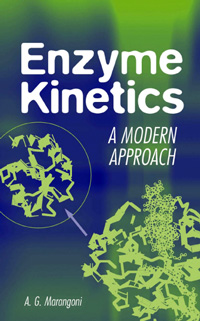Enzyme Kinetics. A Modern Approach
| Автор(ы): | Marangoni A. G.
06.10.2007
|
| Год изд.: | 2003 |
| Описание: | This book is about understanding the principles of enzyme kinetics and knowing how to use mathematical models to describe the catalytic function of an enzyme. Coverage of the material is by no means exhaustive. There exist many books on enzyme kinetics that offer thorough, in-depth treatises of the subject. This book stresses understanding and practicality, and is not meant to replace, but rather to complement, authoritative treatises on the subject such as Segel's Enzyme Kinetics. |
| Оглавление: |
 Обложка книги.
Обложка книги.
1.1 Generalities [1] 1.2 Elementary Rate Laws [2] 1.2.1 Rate Equation [2] 1.2.2 Order of a Reaction [3] 1.2.3 Rate Constant [4] 1.2.4 Integrated Rate Equations [4] 1.2.4.1 Zero-Order Integrated Rate Equation [4] 1.2.4.2 First-Order Integrated Rate Equation [5] 1.2.4.3 Second-Order Integrated Rate Equation [7] 1.2.4.4 Third- Order Integrated Rate Equation [8] 1.2.4.5 Higher-Order Reactions [9] 1.2.4.6 Opposing Reactions [9] 1.2.4.7 Reaction Half-Life [11] 1.2.5 Experimental Determination of Reaction Order and Rate Constants [12] 1.2.5.1 Differential Method (Initial Rate Method) [12] 1.2.5.2 Integral Method [13] 1.3 Dependence of Reaction Rates on Temperature [14] 1.3.1 Theoretical Considerations [14] 1.3.2 Energy of Activation [18] 1.4 Acid-Base Chemical Catalysis [20] 1.5 Theory of Reaction Rates [23] 1.6 Complex Reaction Pathways [26] 1.6.1 Numerical Integration and Regression [28] 1.6.1.1 Numerical Integration [28] 1.6.1.2 Least-Squares Minimization (Regression Analysis) [29] 1.6.2 Exact Analytical Solution (Non-Steady-State Approximation) [39] 1.6.3 Exact Analytical Solution (Steady-State Approximation) [40] 2 HOW DO ENZYMES WORK? [41] 3 CHARACTERIZATION OF ENZYME ACTIVITY [44] 3.1 Progress Curve and Determination of Reaction Velocity [44] 3.2 Catalysis Models: Equilibrium and Steady State [48] 3.2.1 Equilibrium Model [48] 3.2.2 Steady-State Model [49] 3.2.3 Plot of v versus [S] [50] 3.3 General Strategy for Determination of the Catalytic Constants Km and Vmax [52] 3.4 Practical Example [53] 3.5 Determination of Enzyme Catalytic Parameters from the Progress Curve [58] 4 REVERSIBLE ENZYME INHIBITION [61] 4.1 Competitive Inhibition [61] 4.2 Uncompetitive Inhibition [62] 4.3 Linear Mixed Inhibition [63] 4.4 Noncompetitive Inhibition [64] 4.5 Applications [65] 4.5.1 Inhibition of Fumarase by Succinate [65] 4.5.2 Inhibition of Pancreatic Carboxypeptidase A by (?)-Phenylpropionate [67] 4.5.3 Alternative Strategies [69] 5 IRREVERSIBLE ENZYME INHIBITION [70] 5.1 Simple Irreversible Inhibition [72] 5.2 Simple Irreversible Inhibition in the Presence of Substrate [73] 5.3 Time-Dependent Simple Irreversible Inhibition [75] 5.4 Time-Dependent Simple Irreversible Inhibition in the Presence of Substrate [76] 5.5 Differentiation Between Time-Dependent and Time-Independent Inhibition [78] 6 pH DEPENDENCE OF ENZYME-CATALYZED REACTIONS [79] 6.1 The Model [79] 6.2 pH Dependence of the Catalytic Parameters [82] 6.3 New Method of Determining p^T Values of Catalytically Relevant Functional Groups [84] 7 TWO-SUBSTRATE REACTIONS [90] 7.1 Random-Sequential Bi Bi Mechanism [91] 7.1.1 Constant [A] [93] 7.1.2 Constant [B] [93] 7.2 Ordered-Sequential Bi Bi Mechanism [95] 7.2.1 Constant [B] [95] 7.2.2 Constant [A] [96] 7.2.3 Order of Substrate Binding [97] 7.3 Ping-Pong Bi Bi Mechanism [98] 7.3.1 Constant [B] [99] 7.3.2 Constant [A] [99] 7.4 Differentiation Between Mechanisms [100] 8 MULTISITE AND COOPERATIVE ENZYMES [102] 8.1 Sequential Interaction Model [103] 8.1.1 Basic Postulates [103] 8.1.2 Interaction Factors [105] 8.1.3 Microscopic versus Macroscopic Dissociation Constants [106] 8.1.4 Generalization of the Model [107] 8.2 Concerted Transition or Symmetry Model [109] 8.3 Application [114] 8.4 Reality Check [115] 9 IMMOBILIZED ENZYMES [116] 9.1 Batch Reactors [116] 9.2 Plug-Flow Reactors [118] 9.3 Continuous-Stirred Reactors [119] 10 INTERRACIAL ENZYMES [121] 10.1 The Model [122] 10.1.1 Interfacial Binding [122] 10.1.2 Interfacial Catalysis [123] 10.2 Determination of Interfacial Area per Unit Volume [125] 10.3 Determination of Saturation Interfacial Enzyme Coverage [127] 11 TRANSIENT PHASES OF ENZYMATIC REACTIONS [129] 11.1 Rapid Reaction Techniques [130] 11.2 Reaction Mechanisms [132] 11.2.1 Early Stages of the Reaction [134] 11.2.2 Late Stages of the Reaction [135] 11.3 Relaxation Techniques [135] 12 CHARACTERIZATION OF ENZYME STABILITY [140] 12.1 Kinetic Treatment [140] 12.1.1 The Model [140] 12.1.2 Half-Life [142] 12.1.3 Decimal Reduction Time [143] 12.1.4 Energy of Activation [144] 12.1.5 Z Value [145] 12.2 Thermodynamic Treatment [146] 12.3 Example [150] 12.3.1 Thermodynamic Characterization of Stability [151] 12.3.2 Kinetic Characterization of Stability [156] 13 MECHANISM-BASED INHIBITION Leslie J. Copp [158] 13.1 Alternate Substrate Inhibition [159] 13.2 Suicide Inhibition [163] 13.3 Examples [169] 13.3.1 Alternative Substrate Inhibition [169] 13.3.2 Suicide Inhibition [170] 14 PUTTING KINETIC PRINCIPLES INTO PRACTICE Kirk L. Parkin [174] 14.1 Were Initial Velocities Measured? [175] 14.2 Does the Michaelis-Menten Model Fit? [177] 14.3 What Does the Original [S] versus Velocity Plot Look Like? [179] 14.4 Was the Appropriate [S] Range Used? [181] 14.5 Is There Consistency Working Within the Context of a Kinetic Model? [184] 14.6 Conclusions [191] 15 USE OF ENZYME KINETIC DATA IN THE STUDY OF STRUCTURE-FUNCTION RELATIONSHIPS OF PROTEINS Takuji Tanaka and Rickey Y. Yada [193] 15.1 Are Proteins Expressed Using Various Microbial Systems Similar to the Native Proteins? [193] 15.2 What Is the Mechanism of Conversion of a Zymogen to an Active Enzyme? [195] 15.3 What Role Does the Prosegment Play in the Activation and Structure-Function of the Active Enzyme? [198] 15.4 What Role Do Specific Structures and/or Residues Play in the Structure-Function of Enzymes? [202] 15.5 Can Mutations be Made to Stabilize the Structure of an Enzyme to Environmental Conditions? [205] 15.5.1 Charge Distribution [205] 15.5.2 N-Frag Mutant [208] 15.5.3 Disulfide Linkages [210] 15.6 Conclusions [212] 15.7 Abbreviations Used for the Mutation Research [213] BIBLIOGRAPHY [217] Books [217] Selection of Classic Papers [218] INDEX [221] |
| Формат: | djvu |
| Размер: | 1817437 байт |
| Язык: | ENG |
| Рейтинг: |
358
|
| Открыть: | Ссылка (RU) |